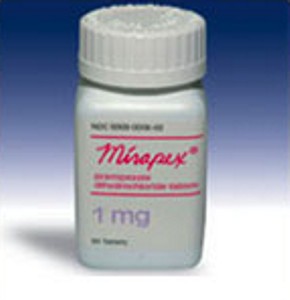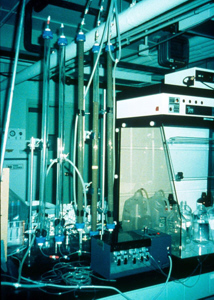 (extended release and immediate release) were similarly effective in Parkinson's Disease and were equally tolerated. In the second clinical trial, both forms of pramipexole were more effective than a placebo. Off times decreased by up to 150 minutes per day, but a placebo achieved an 84 minute reduction in off times, thereby lessening the actual reduction in off time to just over an hour per day. Immediate release pramipexole was slightly more effective than extended-release pramipexole, but otherwise, extended-release pramipexole could be readily substituted for immediate-release pramipexole.
(extended release and immediate release) were similarly effective in Parkinson's Disease and were equally tolerated. In the second clinical trial, both forms of pramipexole were more effective than a placebo. Off times decreased by up to 150 minutes per day, but a placebo achieved an 84 minute reduction in off times, thereby lessening the actual reduction in off time to just over an hour per day. Immediate release pramipexole was slightly more effective than extended-release pramipexole, but otherwise, extended-release pramipexole could be readily substituted for immediate-release pramipexole. WELCOME TO OUR PARKINSON'S PLACE!
I HAVE PARKINSON'S DISEASES AND THOUGHT IT WOULD BE NICE TO HAVE A PLACE WHERE THE CONTENTS OF UPDATED NEWS IS FOUND IN ONE PLACE. THAT IS WHY I BEGAN THIS BLOG.
I COPY NEWS ARTICLES PERTAINING TO RESEARCH, NEWS AND INFORMATION FOR PARKINSON'S DISEASE, DEMENTIA, THE BRAIN, DEPRESSION AND PARKINSON'S WITH DYSTONIA. I ALSO POST ABOUT FUNDRAISING FOR PARKINSON'S DISEASE AND EVENTS. I TRY TO BE UP-TO-DATE AS POSSIBLE.
I AM NOT RESPONSIBLE FOR IT'S CONTENTS. I AM JUST A COPIER OF INFORMATION SEARCHED ON THE COMPUTER. PLEASE UNDERSTAND THE COPIES ARE JUST THAT, COPIES AND AT TIMES, I AM UNABLE TO ENLARGE THE WORDING OR KEEP IT UNIFORMED AS I WISH. IT IS IMPORTANT TO UNDERSTAND I AM A PERSON WITH PARKINSON'S DISEASE. I HAVE NO MEDICAL EDUCATION,
I JUST WANT TO SHARE WITH YOU WHAT I READ ON THE INTERNET. IT IS UP TO YOU TO DECIDE WHETHER TO READ IT AND TALK IT OVER WITH YOUR DOCTOR. I AM JUST THE COPIER OF DOCUMENTS FROM THE COMPUTER. I DO NOT HAVE PROOF OF FACT OR FICTION OF THE ARTICLE. I ALSO TRY TO PLACE A LINK AT THE BOTTOM OF EACH ARTICLE TO SHOW WHERE I RECEIVED THE INFORMATION SO THAT YOU MAY WANT TO VISIT THEIR SITE.
THIS IS FOR YOU TO READ AND TO ALWAYS KEEP AN OPEN MIND.
PLEASE DISCUSS THIS WITH YOUR DOCTOR, SHOULD YOU HAVE ANY QUESTIONS, OR CONCERNS. NEVER DO ANYTHING WITHOUT TALKING TO YOUR DOCTOR FIRST..
I DO NOT MAKE ANY MONEY FROM THIS WEBSITE. I VOLUNTEER MY TIME TO HELP ALL OF US TO BE INFORMED.
I WILL NOT ACCEPT ANY ADVERTISEMENT OR HEALING POWERS, HEALING FROM HERBS AND ETC. UNLESS IT HAS GONE THROUGH TRIALS AND APPROVED BY FDA. IT WILL GO INTO SPAM.
THIS IS A FREE SITE FOR ALL WITH NO ADVERTISEMENTS
THANK YOU FOR VISITING! TOGETHER WE CAN MAKE A DIFFERENCE!
TRANSLATE
Thursday, November 17, 2011
PRAMIPEXOLE CLINICAL TRIAL RESULTS
 (extended release and immediate release) were similarly effective in Parkinson's Disease and were equally tolerated. In the second clinical trial, both forms of pramipexole were more effective than a placebo. Off times decreased by up to 150 minutes per day, but a placebo achieved an 84 minute reduction in off times, thereby lessening the actual reduction in off time to just over an hour per day. Immediate release pramipexole was slightly more effective than extended-release pramipexole, but otherwise, extended-release pramipexole could be readily substituted for immediate-release pramipexole.
(extended release and immediate release) were similarly effective in Parkinson's Disease and were equally tolerated. In the second clinical trial, both forms of pramipexole were more effective than a placebo. Off times decreased by up to 150 minutes per day, but a placebo achieved an 84 minute reduction in off times, thereby lessening the actual reduction in off time to just over an hour per day. Immediate release pramipexole was slightly more effective than extended-release pramipexole, but otherwise, extended-release pramipexole could be readily substituted for immediate-release pramipexole. 14 November- New blog
 The Dopamine Chronicles is the new Parkinson's Disease blog of cartoonist Martin Bee. His blog specialises in Parkinson's Disease cartoons. In the words of Martin Bee "Any of you diagnosed with this disease probably can relate to the reaction. The Dopamine Chronicles is all about me continuing my art, my toons and so on. So I decided to do (almost) a cartoon a day about Parkinson’s and me." Martin Bee is a 60 year old Vietnam Veteran who was a Navy Corpsman stationed with the 1st Marine Division whilst he was in Vietnam. After leaving the Navy, he graduated in Art and then worked in design and illustration. Despite being diagnosed with Parkinson's Disease, which included a shaking right hand, he could still draw. Although Parkinson's Disease hindered his drawing technique, he altered the techniques he used in order to overcome the problems it caused him.
The Dopamine Chronicles is the new Parkinson's Disease blog of cartoonist Martin Bee. His blog specialises in Parkinson's Disease cartoons. In the words of Martin Bee "Any of you diagnosed with this disease probably can relate to the reaction. The Dopamine Chronicles is all about me continuing my art, my toons and so on. So I decided to do (almost) a cartoon a day about Parkinson’s and me." Martin Bee is a 60 year old Vietnam Veteran who was a Navy Corpsman stationed with the 1st Marine Division whilst he was in Vietnam. After leaving the Navy, he graduated in Art and then worked in design and illustration. Despite being diagnosed with Parkinson's Disease, which included a shaking right hand, he could still draw. Although Parkinson's Disease hindered his drawing technique, he altered the techniques he used in order to overcome the problems it caused him. TRICHLOROETHYLENE MULTIPLIES THE RISK OF PARKINSON'S DISEASE
 Exposure to the solvent Trichloroethylene has been found to multiply the risk of Parkinson's Disease by six times. Results were similar for estimates of exposure duration and cumulative lifetime exposure. Trichloroethylene is a solvent that is used extensively in industry and the military and is a common environmental contaminant. It has been used to extract vegetable oils, in coffee decaffeination, and in the preparation of flavouring extracts from hops and spices. Much of its use has been banned because of toxicity. Trichloroethylene is the most common organic contaminant in groundwater, and so can cause toxicity via the water supply. Around 30% of U.S. water supplies are contaminated by Trichloroethylene. For more information go to Trichloroethylene.
Exposure to the solvent Trichloroethylene has been found to multiply the risk of Parkinson's Disease by six times. Results were similar for estimates of exposure duration and cumulative lifetime exposure. Trichloroethylene is a solvent that is used extensively in industry and the military and is a common environmental contaminant. It has been used to extract vegetable oils, in coffee decaffeination, and in the preparation of flavouring extracts from hops and spices. Much of its use has been banned because of toxicity. Trichloroethylene is the most common organic contaminant in groundwater, and so can cause toxicity via the water supply. Around 30% of U.S. water supplies are contaminated by Trichloroethylene. For more information go to Trichloroethylene. Wednesday, November 16, 2011
Dr. Robert Hauser has recently penned an outstanding paper reviewing all the new therapies in the Parkinson's disease pipeline.
Int J Neurosci. 2011;121 Suppl 2:53-62.
Future Treatments for Parkinson's Disease: Surfing the PD Pipeline.
Hauser RA.
Source
Departments of Neurology, Molecular Pharmacology and Physiology, College of Medicine , University of South Florida, Tampa, Florida USA.
Abstract
ABSTRACT Our current wish list for the treatment of Parkinson's disease (PD) includes therapies that will provide robust and sustained antiparkinsonian benefit through the day, ameliorate or prevent dyskinesia, and slow or prevent the progression of the disease. In this article, I review selected new therapies in clinical development for motor features or treatment complications of PD, and some that may slow disease progression. These include adenosine 2a (A2a) antagonists (istradefylline, preladenant, and SYN115), levodopa/carbidopa intestinal gel (LCIG), IPX066-an extended-release formulation of carbidopa/levodopa, XP21279-a sustained-release levodopa prodrug, ND0611-a carbidopa subcutaneous patch, safinamide-a mixed mechanism of action medication that may provide both MAO-B and glutamate inhibition, PMY50028-an oral neurotrophic factor inducer, antidyskinesia medications (AFQ056 and fipamezole), and gene therapies (AAV2-neurturin and glutamic acid decarboxylase gene transfer). Some of these therapies will never be proven efficacious and will not come to market while others may play a key role in the future treatment of PD.
Tuesday, November 15, 2011
Exposure to Toxic Solvents Linked to Parkinson's Disease
As many as 500,000 people in the United States have Parkinson's disease and more than 50,000 new cases are diagnosed in the country each year. Some research suggests that genetic and environmental factors might trigger Parkinson's, and several studies have reported that exposure to solvents may increase the risk.
In this new study, U.S. researchers interviewed 99 pairs of elderly twins about their lifetime occupations and hobbies. Exposure to TCE was associated with a sixfold increased risk of Parkinson's disease. Exposure to perchloroethylene (PERC) and carbon tetrachloride (CCI4) were also associated with increased risk.
The study was led by researchers at The Parkinson's Institute in Sunnyvale, Calif., and was published Nov. 14 in the journal Annals of Neurology.
"Our findings, as well as prior case reports, suggest a lag time of up to 40 years between TCE exposure and onset of [Parkinson's], providing a critical window of opportunity to potentially slow the disease process before clinical symptoms appear," said Dr. Samuel Goldman and colleagues in a journal news release.
While this study focused on job-related exposure, the solvents are common in soil, groundwater and the air in the United States. For example, TCE is detected in up to 30 percent of the nation's drinking water supplies, according to the researchers.
"Our study confirms that common environmental contaminants may increase the risk of developing [Parkinson's], which has considerable public health implications," Goldman and colleagues said.
All three solvents linked to Parkinson's are used extensively worldwide and TCE is a common agent in paints, adhesives, carpet cleaners and dry-cleaning solutions. In the United States, millions of pounds of TCE are released into the environment each year.

